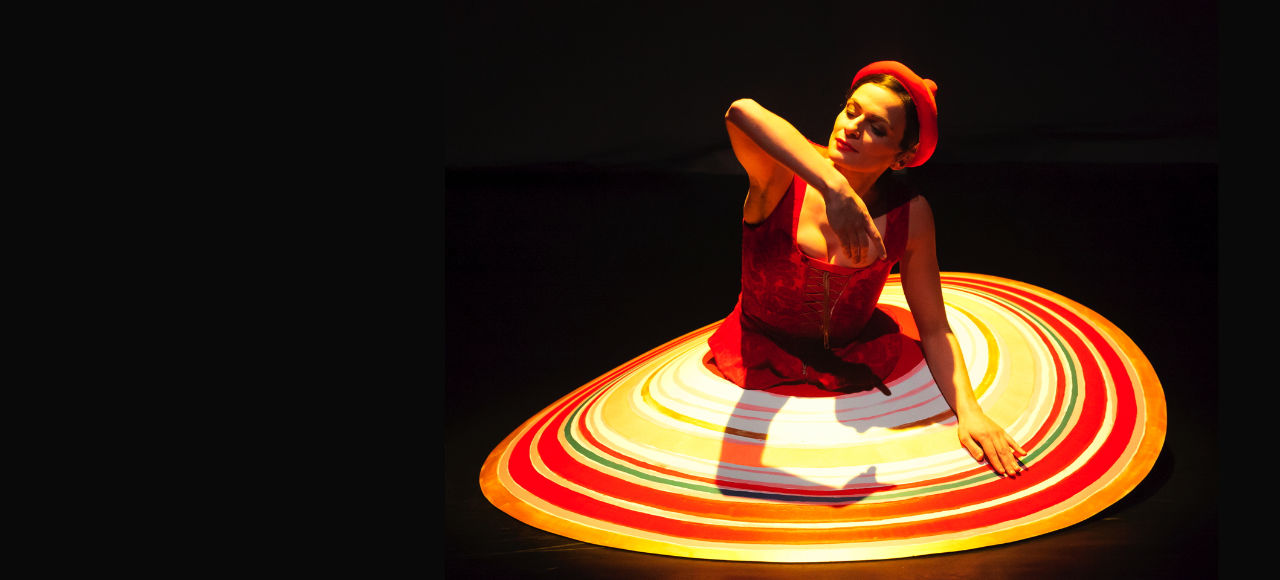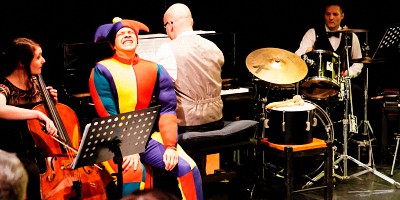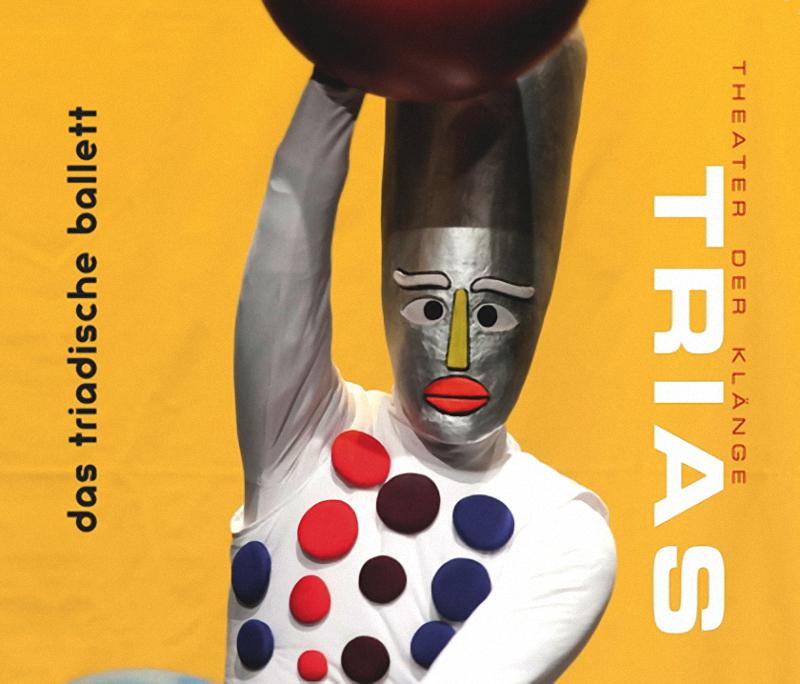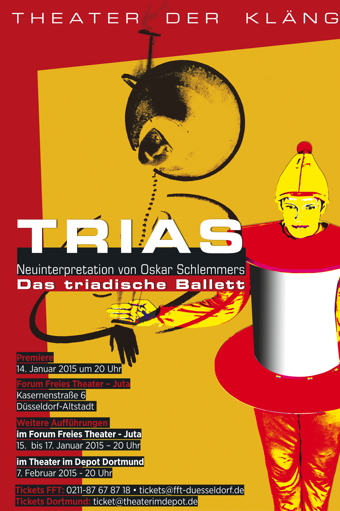
TRIAS
The triadic Ballet
The triadic ballet which flirts with the cheerful without going to ruin of the grotesque, the conventional touches without courting with his depressions, at last Dematerialisation of the bodies strives after without redeveloping itself mystic, should show the beginnings, of the development for german ballet…
Oskar Schlemmer, 1922

Ensemble
Premiere: January 14, 2015 at FFT-Juta Düsseldorf
Staging / Scenography: J.U.Lensing
Choreography: Jacqueline Fischer
Music: Thomas Wansing
Lighting design: Denny Klein
Costumes: Caterina Di Fiore
Figurine production: Caterina Di Fiore and Udo Lensing (Assistants: Johann and J.U.Lensing)
Mask Globe hands: Adriana Kocijan
Mask Taucher: Students of the FH-Dortmund / FB-Design under the direction of Geert Schüttler
Production Manager: J.U.Lensing
Artistic company office: Ulrike Goldmann
Printed matter design: Ernst Merheim
Photos: Oliver Eltinger
Conferencier + Clownerie: Kai Bettermann
Dancers / performers: Kai Bettermann, Darwin Diaz, Elisa Marschall, Phaedra Pisimisi
Piano: Thomas Wansing
Cello: Beate Wolff
Drums: Oliver Eltinger
About the Production
The triadic ballet of Oskar Schlemmer is his most famous work for the theatrestage and this which is connected mostly with the stage of the Bauhaus.
So little it was to be seen during the twenties, the pictures of the ballet are connected today on the reconstructions and new creations of the sixties and seventies. It was necessary to add a new interpretation to these.
Instead of a stiff one to one costumerecreation the costumes are so interpreted as Schlemmer had developed them simply and originally as an enlargement of ballet costumes and stage figurines (also of the puppet theatre). Instead of automated, stare to dehumanised figurines to a mechanised music TRIAS picks out as a central theme the breaking off, the explosion and physical joy and musical action in the music and dance theatre. Instead of a celebration of high constructive Bauhaus art, TRIAS focusses itself on the clowneske and carnival stresses in Oskar Schlemmer’s access to the stage.
TRIAS of the THEATER DER KLAENGE is a new interpretation with the dance and musical possibilities of the 21st century. It ventures in 2014/15 for the first time for nearly 40 years and more than 90 years after his première.
Besides, TRIAS does not want to animate more or less as the inheritance of the classical modern art, but also the mind of the “roaring twenties” and with today’s physical and musical technologies to make a today’s (Bauhaus) stage party!
The piece was newly created in 2014/15 with relatively small financial means by the Theater der Klaenge. Thanks to generous support from the state of North Rhine-Westphalia in 2019 and the ordering of duplicates of our figurines by the Bauhaus Dessau Foundation, also in 2019, a completely new figurine set was created last year, very much based on the originals by Oskar Schlemmer, with which the Theater der Klaenge has been touring since May 2019.
Trias: Press
With it’s first production 28 years ago, the Düsseldorf ensemble, THEATER DER KLÄNGE, already established themselves as Bauhaus-experts. With this production they expand on earlier works, as a matter of fact, one cannot imagine a better remake of the Triadic Ballet than this most excellent adaptation. Not only a contemporary reflected Meta-Schlemmer, but also a loving historical tribute.
Nicole Strecker
WDR3 Mosaik
Düsseldorf’s “Theater der Klänge” presents a magical new interpretation at FFT Juta. The rush is impressive. For the sold out opening-night some people without tickets waited in front of the counter for hours, trying their luck. The performances on the coming weekend are already sold out.
“Trias” offers the audience an exceptional trip full of poetry and humor. The production by J.U. Lensing with Jacqueline Fischer as choreographer keeps exactly to the originaly given sequence of eleven scenes.
Fantastic figures appear: the “top hat man”, the “bell-doll”, the “disc-dancers”, the “glowing-wire-figure”, floating like a shining star fairy over the black stage. Kai Bettermann, as Cello-Clown and ruler over a complete mini-orchestra of his own, cites the revues of the “golden twenties”.
Only the final scene deviates from Schlemmer’s idea of abstraction, and follows another interpretation. Phaedra Pisimisi, Elisa Marschall and Darwin Diaz let their red, yellow and blue crinoline costumes fly. Here, the music becomes still, only the fabric’s rustling is to be heard. Until the three peel off their severe long gowns and a cheerful, physical, play of bodies unfolds.
A well rounded final chord for this uplifting ballet, that celebrates the vitality of the 1920’s and it’s unrestrained lust for dance and movement. The music plays an equal role. When they communicate with one other, then one feels how brilliantly the musicians Thomas Wansing (piano, percussions), Beate Wolff (Cello) and Oliver Eltinger (drums) play. In the end there were loud cheers from the audience for all participants.
Rheinische Post
The audience at Forum Freies Theater Düsseldorf is thrilled – almost as it was 100 years ago, when Oskar Schlemmer presented his “Triadic Ballet” for the first time. The figurines wearing a “plate-tutu” or divers’s mask, a top hat, or “spheres”, glide across the empty stage, provoking thoughtful seriousness or amusement.
Musical and scenic clownery, which are for the most part created by the 18 grotesque and surrealistic costumes, and by playing with a second and third dimension, pass in almost 90 minutes. Director (Jörg U. Lensing) and choreographer (Jacqueline Fischer) orient themselves to the original piece, and to the aesthetics of the twenties, as do the colorful costumes by Caterina di Fiore and the instrumental accompaniment by Thomas Wansing. Cello, piano, percussion and drums drive the twelve bizarre scenes forward, which even today, count as milestones for the arts.
Bottom line: Though this reduced dance performance better fits into a museum, it can certainly still be recommended to friends of the ballet and the fine arts.
Hans-Georg Müller
WAZ
Celebration in forms and colours
In the end, the dance world is ballanced again. Close to the end of the chamber ballet “Trias”, the three dancers slip off their clothes in the trias of colors red, blue and yellow and celebrate an ingenious acrobatic scene. This is how dance works today! And before, a “festival of shapes and colours”, as it is remembered from Bauhaus artist, Oskar Schlemmer, almost 100 years ago.
For the new interpretation’s opening-night on Wednesday, Theater der Klange from Dusseldorf moderated the stiff geometrical costumes from the past with more ductile materials and smooth padding. The small ensemble’s endearing answer is, that the human body is not to be crammed in a completely stiff corset. The opening night’s audience gave a long lasting applause.
Phaedra Pisimisi in her plate-skirt, began the sequence of twelve scenes quietly, with elegant arm gestures and slight tripping on the spot, almost elegiac. Componist Thomas Wansing’s musical accompaniment on piano sounded as clear as an invention of Bach. Music and movement increased like a crescendo.
Magnificent the fiery second spiral (Elisa Marschall). Nobel the metalic discs in profile (Phaedra Pisimisi, Darwin Diaz). The music, complemented by cello (Beate Wolff) and percussion (Oliver Eltinger), maneuvers between moderate modern and dynamic jazz passages. The dancers coquetted and triumphed, at times refreshingly mischievous, over their stiff body-requisites.
Marie-Luise Jeitschko
tanznetz.de
Drahtleuchtfigur und Goldkugeln
Upcoming Shows
Day(s)
:
Hour(s)
:
Minute(s)
:
Second(s)



